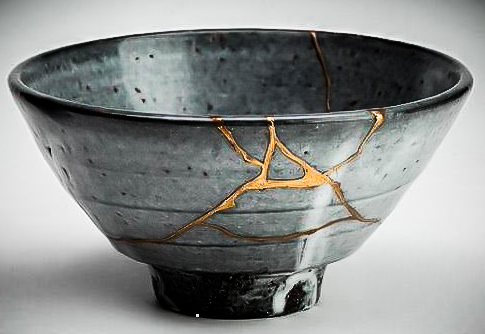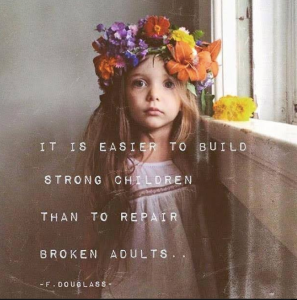The Japanese art of Kintsugi can teach us a valuable lesson: it is the art to repair broken pottery with lacquer dusted or mixed with powdered gold, silver or platinum (a method similar to the maki-e technique) (cfr. more on Wikipedia).

Kintsugi
“The vicissitudes of existence over time, to which all humans are susceptible, could not be clearer than in the breaks, the knocks, and the shattering to which ceramic ware too is subject.
This poignancy or aesthetic of existence has been known in Japan as mono no aware, a compassionate sensitivity, or perhaps identification with, [things] outside oneself.” Christy Bartlett, Flickwerk The Aesthetics of Mended Japanese Ceramics (cfr. mono no aware “the pathos of things”).
I use this image when I talk about Resilience because it teaches the most important strategy to overcome hardship: the positive outlook, the optimism that should never diminish. But we need to have experienced the positive outcome in order to recognize the chance we have to make our cracks shine. Someone said the cracks are where the light comes in, and it is true. We learn through hardships, through failure and personal experience.
When we experience hardship in life, some say “why me?”, ending up in a victim’s stage which can be necessary at the beginning to gather forces, but this stage should never last too long, because we would remain passive puppets in our lives play. So this “why me?” should be reformulated as “why not me?”: what is there in this difficult experience that I can learn from?
It doesn’t mean that we don’t suffer, that we don’t feel pain, that we’re not up to a rollercoaster of pain and joy, hope and failure, but it means that we find a reason to go on, to grow with it.
With this dynamic thinking we can build bridges from our hardships to a better future. These bridges make the present more manageable. This doesn’t mean that we “live in the future” and are not focused on the “here and now”, it means that we are not “stuck” in the here and now, in the present, overwhelming situation.
Viktor E. Frankl, an Austrian psychiatrist and an Auschwitz survivor, articulated this concept beautifully in his “meaning therapy”, a humanistic therapy technique that helps individuals make the kinds of decisions that will create significance in their lives. In his book Man’s Search for Meaning, Frankl described the pivotal moment in the camp when he developed meaning therapy.
“We must never forget that we may also find meaning in life even when confronted with a hopeless situation, when facing a fate that cannot be changed.”
But meaning can be elusive: just because we found it once doesn’t mean we’ll keep it or find it again! What we can learn is to have faith in the fact that in every situation we can gain a positive perspective.
We may need help with this, but there is always a way to make it become even more beautiful and precious than before, like the art of kintsugi.
Following what French anthropologist Claude Levi-Strauss calls “skill bricolage“, in the modern sense can be defined as a kind of inventiveness. It is the ability to improvise a solution to a problem without proper or obvious tools or materials. Bricoleurs manage to muddle trough, imagine alternative ways when situations unravel. This is when in a difficult situation we scan our options and find a way to cope with it with the tools we have at hand. The important aspect is that we “do”!
***
We can’t change things from happening, we can only change the way we respond and deal with them.
“It is not the strongest of the species that survives, nor the most intelligent, but the one the most responsive to change” (Charles Darwin)
You can find out more about my Resilience trainings and programs here.
Categories: Culture/Traditions







This arrives at the right time for me. The latest change in my life came not of my choosing but by force of circumstances. I find it very difficult to adapt. The weight of aging also contributes to my difficulties.
In my life I always loved change, but this time it is doing me in… Thanks for this encouraging post. I shall reflect on it
LikeLike
Vera, I’m sorry to hear this. Change can be hard to accept, I know. It’s easily said that “there must be a nice side on everything”, especially when that change makes us sad and hurt. When we choose change, we are usually ready for it. When change is imposed by others or by circumstances, we usually are not ready and this is what it makes it so difficult to accept. But we have still the opportunity to grow with that change: we know by experience that we’ve overcome hardships before, we dealt with them and we’re still here. Adapting with change we didn’t choose takes time and a lot of convincing and finding a way to look at our situation in a way that makes it less painful. – I really hope you can find the silver lining (or the golden lining) in your change.
Ti auguro di cuore ogni bene, Vera! xxx
LikeLiked by 1 person
Thank you, grazie ugualmente di cuore. V.
LikeLiked by 1 person